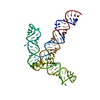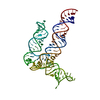+ データを開く
データを開く
- 基本情報
基本情報
| 登録情報 | データベース: PDB / ID: 8uye | ||||||||||||||||||||||||||||||||||||
|---|---|---|---|---|---|---|---|---|---|---|---|---|---|---|---|---|---|---|---|---|---|---|---|---|---|---|---|---|---|---|---|---|---|---|---|---|---|
| タイトル | BtCoV-HKU5 5' proximal stem-loop 5, conformation 1 | ||||||||||||||||||||||||||||||||||||
 要素 要素 | BtCoV-HKU5 5' proximal stem-loop 5 | ||||||||||||||||||||||||||||||||||||
 キーワード キーワード | RNA / SL5 / coronavirus / 5' UTR | ||||||||||||||||||||||||||||||||||||
| 機能・相同性 | RNA / RNA (> 10) / RNA (> 100) 機能・相同性情報 機能・相同性情報 | ||||||||||||||||||||||||||||||||||||
| 生物種 |  Pipistrellus bat coronavirus HKU5 (ウイルス) Pipistrellus bat coronavirus HKU5 (ウイルス) | ||||||||||||||||||||||||||||||||||||
| 手法 | 電子顕微鏡法 / 単粒子再構成法 / クライオ電子顕微鏡法 / 解像度: 5.9 Å | ||||||||||||||||||||||||||||||||||||
 データ登録者 データ登録者 | Kretsch, R.C. / Xu, L. / Zheludev, I.N. / Zhou, X. / Huang, R. / Nye, G. / Li, S. / Zhang, K. / Chiu, W. / Das, R. | ||||||||||||||||||||||||||||||||||||
| 資金援助 |  米国, 11件 米国, 11件
| ||||||||||||||||||||||||||||||||||||
 引用 引用 |  ジャーナル: Proc Natl Acad Sci U S A / 年: 2024 ジャーナル: Proc Natl Acad Sci U S A / 年: 2024タイトル: Tertiary folds of the SL5 RNA from the 5' proximal region of SARS-CoV-2 and related coronaviruses. 著者: Rachael C Kretsch / Lily Xu / Ivan N Zheludev / Xueting Zhou / Rui Huang / Grace Nye / Shanshan Li / Kaiming Zhang / Wah Chiu / Rhiju Das /   要旨: Coronavirus genomes sequester their start codons within stem-loop 5 (SL5), a structured, 5' genomic RNA element. In most alpha- and betacoronaviruses, the secondary structure of SL5 is predicted to ...Coronavirus genomes sequester their start codons within stem-loop 5 (SL5), a structured, 5' genomic RNA element. In most alpha- and betacoronaviruses, the secondary structure of SL5 is predicted to contain a four-way junction of helical stems, some of which are capped with UUYYGU hexaloops. Here, using cryogenic electron microscopy (cryo-EM) and computational modeling with biochemically determined secondary structures, we present three-dimensional structures of SL5 from six coronaviruses. The SL5 domain of betacoronavirus severe-acute-respiratory-syndrome-related coronavirus 2 (SARS-CoV-2), resolved at 4.7 Å resolution, exhibits a T-shaped structure, with its UUYYGU hexaloops at opposing ends of a coaxial stack, the T's "arms." Further analysis of SL5 domains from SARS-CoV-1 and MERS (7.1 and 6.4 to 6.9 Å resolution, respectively) indicate that the junction geometry and inter-hexaloop distances are conserved features across these human-infecting betacoronaviruses. The MERS SL5 domain displays an additional tertiary interaction, which is also observed in the non-human-infecting betacoronavirus BtCoV-HKU5 (5.9 to 8.0 Å resolution). SL5s from human-infecting alphacoronaviruses, HCoV-229E and HCoV-NL63 (6.5 and 8.4 to 9.0 Å resolution, respectively), exhibit the same coaxial stacks, including the UUYYGU-capped arms, but with a phylogenetically distinct crossing angle, an X-shape. As such, all SL5 domains studied herein fold into stable tertiary structures with cross-genus similarities and notable differences, with implications for potential protein-binding modes and therapeutic targets. #1:  ジャーナル: bioRxiv / 年: 2023 ジャーナル: bioRxiv / 年: 2023タイトル: Tertiary folds of the SL5 RNA from the 5' proximal region of SARS-CoV-2 and related coronaviruses. 著者: Rachael C Kretsch / Lily Xu / Ivan N Zheludev / Xueting Zhou / Rui Huang / Grace Nye / Shanshan Li / Kaiming Zhang / Wah Chiu / Rhiju Das /   要旨: Coronavirus genomes sequester their start codons within stem-loop 5 (SL5), a structured, 5' genomic RNA element. In most alpha- and betacoronaviruses, the secondary structure of SL5 is predicted to ...Coronavirus genomes sequester their start codons within stem-loop 5 (SL5), a structured, 5' genomic RNA element. In most alpha- and betacoronaviruses, the secondary structure of SL5 is predicted to contain a four-way junction of helical stems, some of which are capped with UUYYGU hexaloops. Here, using cryogenic electron microscopy (cryo-EM) and computational modeling with biochemically-determined secondary structures, we present three-dimensional structures of SL5 from six coronaviruses. The SL5 domain of betacoronavirus SARS-CoV-2, resolved at 4.7 Å resolution, exhibits a T-shaped structure, with its UUYYGU hexaloops at opposing ends of a coaxial stack, the T's "arms." Further analysis of SL5 domains from SARS-CoV-1 and MERS (7.1 and 6.4-6.9 Å resolution, respectively) indicate that the junction geometry and inter-hexaloop distances are conserved features across the studied human-infecting betacoronaviruses. The MERS SL5 domain displays an additional tertiary interaction, which is also observed in the non-human-infecting betacoronavirus BtCoV-HKU5 (5.9-8.0 Å resolution). SL5s from human-infecting alphacoronaviruses, HCoV-229E and HCoV-NL63 (6.5 and 8.4-9.0 Å resolution, respectively), exhibit the same coaxial stacks, including the UUYYGU-capped arms, but with a phylogenetically distinct crossing angle, an X-shape. As such, all SL5 domains studied herein fold into stable tertiary structures with cross-genus similarities, with implications for potential protein-binding modes and therapeutic targets. | ||||||||||||||||||||||||||||||||||||
| 履歴 |
|
- 構造の表示
構造の表示
| 構造ビューア | 分子:  Molmil Molmil Jmol/JSmol Jmol/JSmol |
|---|
- ダウンロードとリンク
ダウンロードとリンク
- ダウンロード
ダウンロード
| PDBx/mmCIF形式 |  8uye.cif.gz 8uye.cif.gz | 2.7 MB | 表示 |  PDBx/mmCIF形式 PDBx/mmCIF形式 |
|---|---|---|---|---|
| PDB形式 |  pdb8uye.ent.gz pdb8uye.ent.gz | 2.3 MB | 表示 |  PDB形式 PDB形式 |
| PDBx/mmJSON形式 |  8uye.json.gz 8uye.json.gz | ツリー表示 |  PDBx/mmJSON形式 PDBx/mmJSON形式 | |
| その他 |  その他のダウンロード その他のダウンロード |
-検証レポート
| 文書・要旨 |  8uye_validation.pdf.gz 8uye_validation.pdf.gz | 999 KB | 表示 |  wwPDB検証レポート wwPDB検証レポート |
|---|---|---|---|---|
| 文書・詳細版 |  8uye_full_validation.pdf.gz 8uye_full_validation.pdf.gz | 1015.8 KB | 表示 | |
| XML形式データ |  8uye_validation.xml.gz 8uye_validation.xml.gz | 38.3 KB | 表示 | |
| CIF形式データ |  8uye_validation.cif.gz 8uye_validation.cif.gz | 81 KB | 表示 | |
| アーカイブディレクトリ |  https://data.pdbj.org/pub/pdb/validation_reports/uy/8uye https://data.pdbj.org/pub/pdb/validation_reports/uy/8uye ftp://data.pdbj.org/pub/pdb/validation_reports/uy/8uye ftp://data.pdbj.org/pub/pdb/validation_reports/uy/8uye | HTTPS FTP |
-関連構造データ
| 関連構造データ |  42801MC  8uygC  8uyjC  8uykC  8uylC  8uymC  8uypC  8uysC M: このデータのモデリングに利用したマップデータ C: 同じ文献を引用 ( |
|---|---|
| 類似構造データ | 類似検索 - 機能・相同性  F&H 検索 F&H 検索 |
- リンク
リンク
- 集合体
集合体
| 登録構造単位 | 
|
|---|---|
| 1 |
|
- 要素
要素
| #1: RNA鎖 | 分子量: 43510.676 Da / 分子数: 1 / 由来タイプ: 合成 由来: (合成)  Pipistrellus bat coronavirus HKU5 (ウイルス) Pipistrellus bat coronavirus HKU5 (ウイルス) |
|---|
-実験情報
-実験
| 実験 | 手法: 電子顕微鏡法 |
|---|---|
| EM実験 | 試料の集合状態: PARTICLE / 3次元再構成法: 単粒子再構成法 |
- 試料調製
試料調製
| 構成要素 | 名称: BtCoV-HKU5 5' proximal stem-loop 5, conformation 1 / タイプ: COMPLEX / Entity ID: all / 由来: RECOMBINANT | |||||||||||||||
|---|---|---|---|---|---|---|---|---|---|---|---|---|---|---|---|---|
| 分子量 | 値: 0.04373 MDa / 実験値: NO | |||||||||||||||
| 由来(天然) | 生物種:  Pipistrellus bat coronavirus HKU5 (ウイルス) Pipistrellus bat coronavirus HKU5 (ウイルス) | |||||||||||||||
| 由来(組換発現) | 生物種: synthetic construct (人工物) | |||||||||||||||
| 緩衝液 | pH: 8 | |||||||||||||||
| 緩衝液成分 |
| |||||||||||||||
| 試料 | 濃度: 1.31 mg/ml / 包埋: NO / シャドウイング: NO / 染色: NO / 凍結: YES | |||||||||||||||
| 試料支持 | グリッドの材料: COPPER / グリッドのサイズ: 300 divisions/in. / グリッドのタイプ: Quantifoil R1.2/1.3 | |||||||||||||||
| 急速凍結 | 装置: FEI VITROBOT MARK IV / 凍結剤: ETHANE / 湿度: 100 % / 凍結前の試料温度: 278 K |
- 電子顕微鏡撮影
電子顕微鏡撮影
| 実験機器 |  モデル: Titan Krios / 画像提供: FEI Company |
|---|---|
| 顕微鏡 | モデル: TFS KRIOS |
| 電子銃 | 電子線源:  FIELD EMISSION GUN / 加速電圧: 300 kV / 照射モード: FLOOD BEAM FIELD EMISSION GUN / 加速電圧: 300 kV / 照射モード: FLOOD BEAM |
| 電子レンズ | モード: BRIGHT FIELD / 倍率(公称値): 96000 X / 最大 デフォーカス(公称値): 2000 nm / 最小 デフォーカス(公称値): 1000 nm / Cs: 2.7 mm / C2レンズ絞り径: 70 µm / アライメント法: COMA FREE |
| 試料ホルダ | 凍結剤: NITROGEN 試料ホルダーモデル: FEI TITAN KRIOS AUTOGRID HOLDER |
| 撮影 | 平均露光時間: 4.1 sec. / 電子線照射量: 50 e/Å2 フィルム・検出器のモデル: FEI FALCON IV (4k x 4k) 撮影したグリッド数: 2 / 実像数: 18139 詳細: Data was collected in two session, 5,728 images were collected with a 4.74s exposure time, 12,411 images where collected with a 3.81s exposure time. |
| 画像スキャン | 横: 4096 / 縦: 4096 |
- 解析
解析
| EMソフトウェア |
| ||||||||||||||||||||||||||||||||||||||||||||||||||
|---|---|---|---|---|---|---|---|---|---|---|---|---|---|---|---|---|---|---|---|---|---|---|---|---|---|---|---|---|---|---|---|---|---|---|---|---|---|---|---|---|---|---|---|---|---|---|---|---|---|---|---|
| CTF補正 | タイプ: PHASE FLIPPING AND AMPLITUDE CORRECTION | ||||||||||||||||||||||||||||||||||||||||||||||||||
| 粒子像の選択 | 選択した粒子像数: 5109283 | ||||||||||||||||||||||||||||||||||||||||||||||||||
| 対称性 | 点対称性: C1 (非対称) | ||||||||||||||||||||||||||||||||||||||||||||||||||
| 3次元再構成 | 解像度: 5.9 Å / 解像度の算出法: FSC 0.143 CUT-OFF / 粒子像の数: 163382 / アルゴリズム: FOURIER SPACE / クラス平均像の数: 1 / 対称性のタイプ: POINT | ||||||||||||||||||||||||||||||||||||||||||||||||||
| 原子モデル構築 | プロトコル: OTHER / 空間: REAL |
 ムービー
ムービー コントローラー
コントローラー














 PDBj
PDBj





























